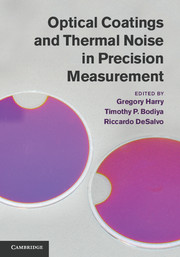Book contents
- Frontmatter
- Contents
- List of contributors
- Foreword
- Preface
- 1 Theory of thermal noise in optical mirrors
- 2 Coating technology
- 3 Compendium of thermal noises in optical mirrors
- 4 Coating thermal noise
- 5 Direct measurements of coating thermal noise
- 6 Methods of improving thermal noise
- 7 Substrate thermal noise
- 8 Cryogenics
- 9 Thermo-optic noise
- 10 Absorption and thermal issues
- 11 Optical scatter
- 12 Reflectivity and thickness optimization
- 13 Beam shaping
- 14 Gravitational wave detection
- 15 High-precision laser stabilization via optical cavities
- 16 Quantum optomechanics
- 17 Cavity quantum electrodynamics
- References
11 - Optical scatter
Published online by Cambridge University Press: 05 January 2012
- Frontmatter
- Contents
- List of contributors
- Foreword
- Preface
- 1 Theory of thermal noise in optical mirrors
- 2 Coating technology
- 3 Compendium of thermal noises in optical mirrors
- 4 Coating thermal noise
- 5 Direct measurements of coating thermal noise
- 6 Methods of improving thermal noise
- 7 Substrate thermal noise
- 8 Cryogenics
- 9 Thermo-optic noise
- 10 Absorption and thermal issues
- 11 Optical scatter
- 12 Reflectivity and thickness optimization
- 13 Beam shaping
- 14 Gravitational wave detection
- 15 High-precision laser stabilization via optical cavities
- 16 Quantum optomechanics
- 17 Cavity quantum electrodynamics
- References
Summary
Introduction
Many high precision optical measurements require high laser power, low optical loss or a combination of both to achieve their sensitivity requirements. Optical loss in an apparatus is often dominated by light scattering from coatings while optical absorption sets limits on the advances that can be made with higher optical power. In some cases, the achievable sensitivity given these limits is not sufficient and experiments require more advanced techniques such as a manipulation of the quantum behavior of light or avoiding any transmissive optics. In this chapter we give an overview of our current understanding of scattered light from high performance coatings. We also present simple overviews on squeezed light, in Section 11.3, and diffractive optics, in Section 11.4.
Optical loss
Optical power loss in experiments can result from a variety of processes; scattering, absorption, transmission, polarization effects, and imperfect quantum efficiency in detection. Some precision optical measurements are limited by the standard quantum limit, discussed in Section 1.4 and below in Section 11.3, where optical power becomes a key parameter in sensitivity. When position of a test mass is measured interferometrically, the signal will scale linearly with the laser power while the quantum shot noise increases as the square-root of power. In these situations, the signal-to-shot-noise ratio will increase proportionally to the square-root of the power. Optical loss can limit the achievable power in a system, and degrade this signal-to-noise ratio. It is also a limiting factor in the quantum noise reduction achievable with squeezed states of light, as discussed below in Section 11.3.
- Type
- Chapter
- Information
- Optical Coatings and Thermal Noise in Precision Measurement , pp. 163 - 172Publisher: Cambridge University PressPrint publication year: 2012
- 1
- Cited by



